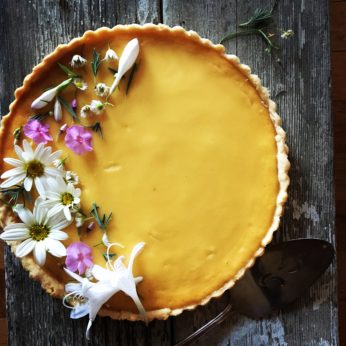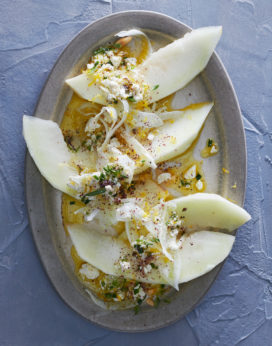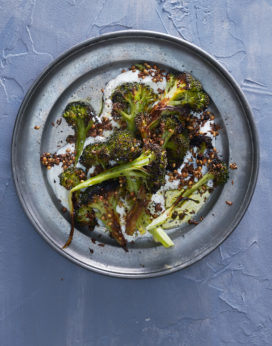When you tear a piece of basil or cut open a lemon, what you smell are terpenes, a wide and diverse group of organic compounds found in plants, fruits and vegetables that make them smell and taste the way they do.
They help plants attract insects for pollination and repel predators. Beyond their adaptive and evolutionary purposes, terpenes make your food smell and taste delicious, and some claim that they have a wide range of health benefits. Each terpene is associated with unique effects. Linalool, a terpene found in lavender, is widely used to reduce anxiety and promote stress relief. Limonene, a terpene found in citrus, is said to increase focus, boost metabolism and relieve heartburn.
Terpenes are also responsible for the taste and smell of cannabis. There are hundreds of strains of cannabis, each with a different makeup of dominant terpenes. More than 100 different types of terpenes have been found in the cannabis plant, which explains why the plant can sometimes smell skunky, floral and piney. Strains like Sour Tangie and Lemon Haze have notes of lemon and lime due to high concentrations of the terpene limonene. The diverse bouquet of terpenes found in cannabis is pretty cool, but perhaps the most interesting aspect is the way terpenes interact with cannabinoids, the chemical compounds found in the cannabis plant, most notably tetrahydrocannabinol (THC) and cannabidiol (CBD).
A phenomenon known as “the entourage effect” suggests that terpenes and cannabinoids work together to produce a number of therapeutic effects. Terpenes work with CBD, THC and other cannabinoids to create a union of compounds that can achieve better results as a group than they would in isolation. The levels of THC and CBD and presence of certain terpenes influence what effects the strain will have on your mood and health. This might explain why people with certain medical conditions seem to benefit more from one strain over another with a similar THC level.
Currently, there isn’t enough research to confirm the entourage effect, mainly because of massive roadblocks in clinical trials due to the fact that cannabis has been illegal. We are just beginning to scratch the surface of the nuances associated with cannabis connoisseurship. This burgeoning research will allow us to determine the potential health benefits of cannabis terpenes and the prospective tastes and smells they offer the palate. I’ve created a few recipes that were inspired by the terpenes found in cannabis. Make note that these recipes don’t have any cannabis in them, so if you or someone you are cooking for is shy about getting high, rest assured these recipes are safe for everyone.
 Lavender Chamomile Honey Tart
Lavender Chamomile Honey Tart
This tart is infused with a variety of terpenes that are said to help with stress relief. Linalool, a cannabis terpene also found in lavender, and bisabolol, a cannabis terpene found in chamomile, have anti-anxiety properties that can help you relax and sleep better. This tart is perfect for a weekend with afternoon tea or as an after-dinner sweet.
Cannabis strains that exhibit linalool-rich terpene profiles include Amnesia Haze, Lavender and LA Confidential.
INGREDIENTS
For the pastry:
1¼ cups all purpose flour, plus more for dusting
½ tsp salt
2 tbsp sugar
½ cup cold unsalted butter, cut into cubes
1½ tbsp lemon juice
4 to 5 tsp ice water
For the custard:
2 cups table cream
3 tbsp loose chamomile tea (or 2 tea bags)
1 tbsp dry lavender
2 cloves
1 cinnamon stick
4 cardamom pods
3 egg yolks
¼ cup granulated sugar
½ cup wildflower honey
1 cup mascarpone cheese
edible flowers (optional)
- In a food processor, mix flour, salt and sugar. Add in butter and pulse until butter is evenly dispersed into pea-size pieces.
- Add lemon juice and pulse. Run the food processor while you add water, teaspoon by teaspoon, through the spout on top. The dough should come together into a smooth ball.
- Form the dough into a disc, wrap with plastic wrap and refrigerate for at least 1 hour.
- Meanwhile, get started on the tart filling by heating the cream in a small pot over medium. Bring to a very gentle simmer, then remove from heat. Add chamomile, lavender, cloves, cinnamon and cardamom pods to cream. Let steam for at least 1 hour or up to 3 hours.
- Roll out chilled dough on a floured surface until a circle forms, about 12 inches in diameter and ¼ inch thick.
- Preheat oven to 425°F. Grease a 9-inch tart pan with a removable bottom. Place rolled-out dough into the tart pan and gently press into and up sides. Discard excess dough. Poke the surface of the dough with a fork several times (this will allow the steam to release). Place a piece of parchment paper over dough and arrange baking beans in an even layer overtop. Place tart pan on a baking sheet.
- Bake blind until edges of crust begin to turn golden, about 12 minutes. Remove from oven and discard baking beans. Place back in oven for an additional 10 minutes.
- Reduce oven temperature to 350°F. Mix egg yolks, sugar and honey in a bowl.
- Strain cream and discard tea, cloves, cinnamon and cardamom pods. Place cream back into a small pot and reheat to a gentle simmer.
- Temper egg mixture by pouring about ¼ cup of the warm cream into the egg mixture and stir gently. Pour egg mixture into pot with remaining cream. Continue to heat mixture over low until thick enough to coat the back of a spoon, stirring continuously.
- Whisk in mascarpone cheese and stir until mixture is completely smooth and uniform.
- Pour mixture into tart shell. Bake until custard has set, about 40 minutes. The custard will still have a slight jiggle but will continue to set once removed from the oven. Let cool on countertop until it reaches room temperature, about 30 minutes.
- Garnish with edible flowers and serve.
Melon Salad with Fennel, Lemon Verbena and Feta
This salad is an unlikely combination of melon and fennel and a magical mixture of fragrant herbs. Lemon verbena and thyme contain the terpene myrcene, which is one of the most abundant terpenes found in cannabis and is said to have pain-relieving properties. Limonene, another terpene found in cannabis that is also found in sumac and lemon, can elevate your mood, reduce stress and create a state of euphoria. So get happy and eat some salad!
Cannabis strains that exhibit limonene-rich terpene profiles include Lemon Haze, Durban Poison and Jack Herer.
INGREDIENTS
½ small canary melon, seeded, peeled and cut into 1-inch-thick slices
1½ cups thinly sliced fennel
1/3 cup crumbled feta cheese
¼ cup extra-virgin olive oil
1 tsp sumac
1 tsp lemon zest
1 tsp chopped fresh thyme
2 tbsp lemon verbena
lemon juice
salt and pepper
- Arrange melon slices on a plate and top with fennel.
- In a small bowl, mix feta, olive oil, sumac and lemon zest. Pour contents over melon and fennel.
- Garnish with thyme and lemon verbena.
- Squeeze over some fresh lemon juice and season with salt and pepper.
Charred Broccoli with Coriander and Cumin Seeds
Broccoli gets a hip makeover in this recipe. The green vegetable gets dressed with loads of nutty cumin and fragrant coriander and sits on a thick, creamy bed of yogurt. Humulene, a terpene described as nutty and earthy, is found in many strains of cannabis and is also present in coriander. It’s known to have anti-inflammatory, cancer-fighting and pain-relieving properties. Broccoli has the terpene beta-caryophyllene, which is said to have a wide range of disease-fighting properties. Dive into this dish and let the healing begin.
Cannabis strains that exhibit humulene-rich terpene profiles include Northern Lights, Durban Poison and Platinum OG.
INGREDIENTS
1 head broccoli, cut into florets
3 tbsp olive oil
3 tbsp raw apple cider vinegar
2 tbsp cumin seeds
1 tbsp coriander seeds
1 cup Greek yogurt
salt and pepper
- Heat grill over medium high. Place florets in a bowl and toss with 2 tbsp olive oil to coat.
- Place florets on grill and cook until lightly charred on all sides, about 2 minutes per side.
- Remove from grill and place in a bowl. Immediately toss with vinegar (it will absorb better while the florets are piping hot).
- Heat a skillet over high. Place cumin and coriander in a skillet and cook until toasted and fragrant, about 5 minutes.
- Place toasted seeds and nuts into bowl with broccoli; toss to coat.
- Smear Greek yogurt on a platter. Place broccoli on yogurt. Drizzle with remaining olive oil. Season with salt and pepper.
 Lavender Chamomile Honey Tart
Lavender Chamomile Honey Tart

Wow! I’m creating a blog about regulate ADHD symptoms with a diet focused on cannabinoids and terpenes. I just find your blog out, and I’m so inspired because cooking focus on terpenes is such a new topic around and even cannabis users are so skeptical about it. Please keep working!
wonderful !!!!!
This is interesting, fresh, inspiring, and beautiful! Thanks!
Nice job!
Great job! Super informative.
Enjoy your terpene-infused, lovingly prepared dinner! Terpenes will quickly become a pantry staple if you start incorporating them into your recipes. Terpenes have been studied for a variety of medical purposes and have a number of health benefits. Antiviral effects of terpenes have been explored. Certain terpene isolate have also been linked to the treatment of cancer and diabetes. Terpenes are known to give cannabis consumers a better experience without the usual side effects. In addition to these benefits, terpenes are known for their anti-inflammatory, analgesic, anti-bacterial, and anti-depressant properties.